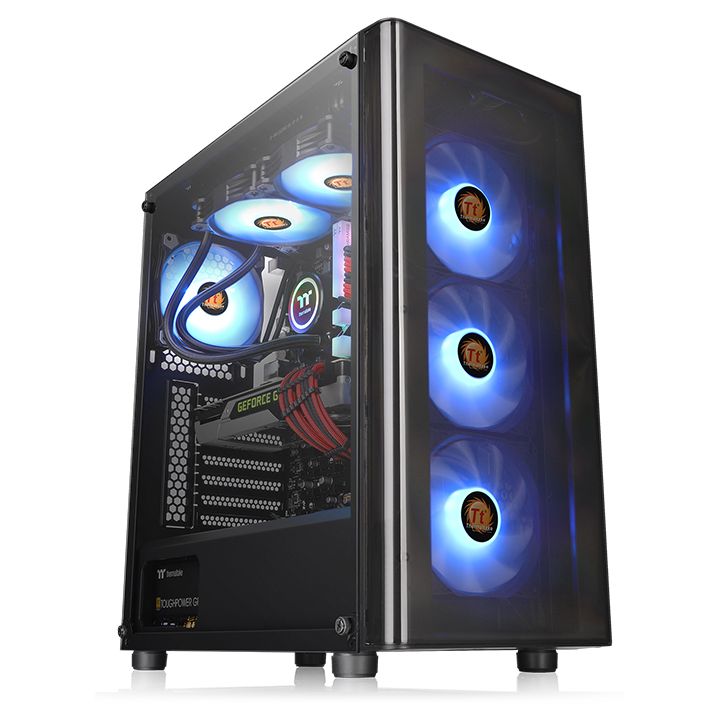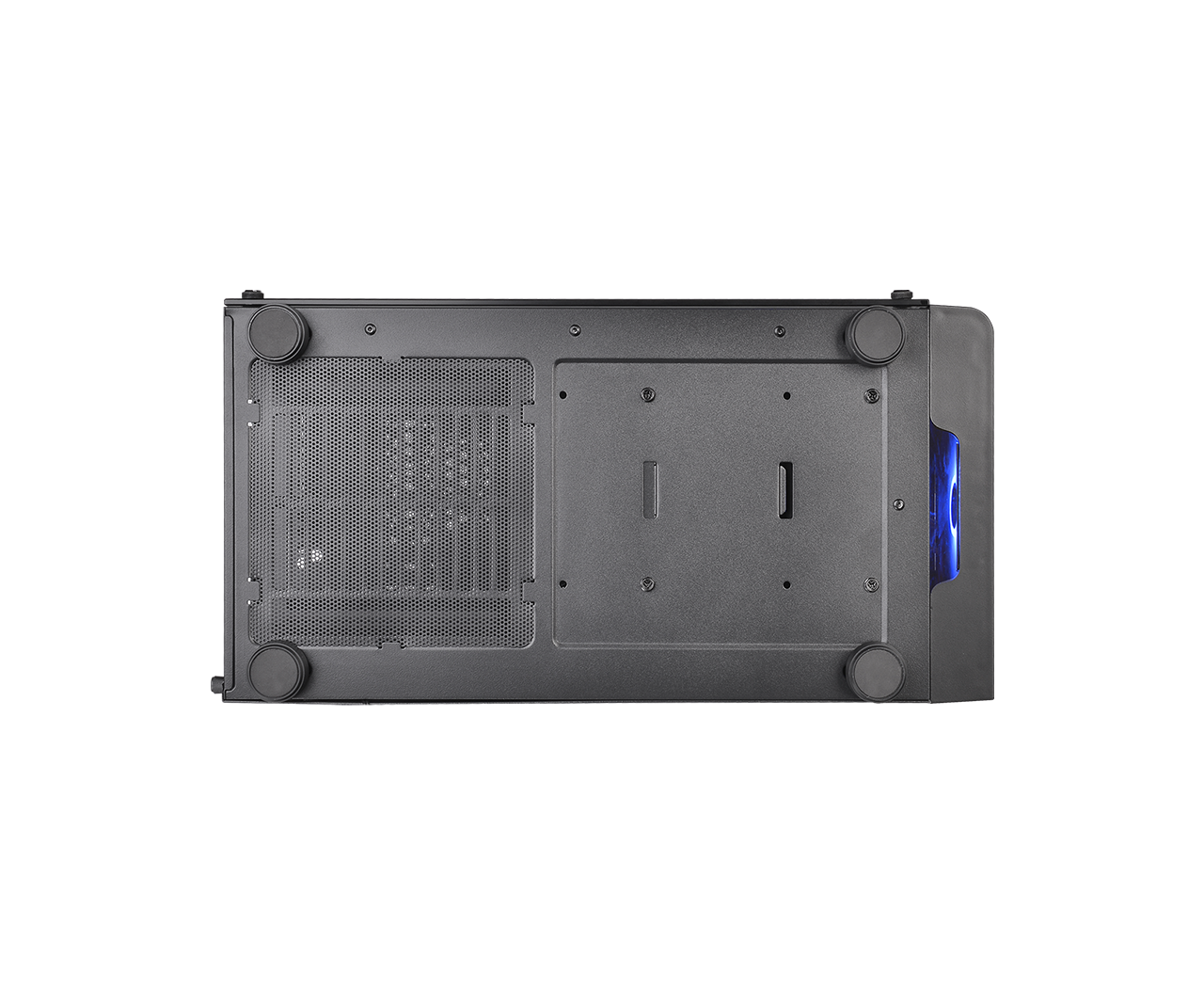Thermaltake V200 Tempered Glass RGB Edition Review - Affordable RGB Gaming Cabinet for PC Under Rs 5000.
In the last three years, RGB has become an important feature for PC components. You have RGB Fans, RGB Cases, RGB PSUs, RGB RAM sticks Even Power Cables come in RGB now. Thermaltake v200 is of such options where RGB and Tempered Glass are headline features. We have tested it and used and there are certain tidbits that we would like to share with you.
Thermaltake v200 follows all the modern case trends. You will have a squared, boxy design, 3 RGB Fans, Tempered glass panels and a PSU shroud too. At the front you have a dark tinted acrylic panel behind which are three RGB Fans. We will discuss about them shortly. The left panel is a tempered glass piece which mounts via four thumbscrews. The panel is basic and relatively easy to mount and dismount. The overall build quality of the fans and build quality of the whole RGB Gaming Cabinet is quite acceptable when you consider the budget.
There are 2 120/140mm fan mounts at the top along with a magnetic dust filter to prevent dust to the build up. The fan mounts are a little offset to ease radiator and fan installation clearance. You will also find the I/O area of Thermaltake V200 RGB Gaming Cabinet at the top which consists of power/reset buttons, two USB 2 ports, audio jacks one USB 3 port and LED control button. In my opinion, a single USB 3 port is not sufficient at least in the year 2020, so this was a little disappointing.
The things are simple at the bottom. You get a dust filter for the power supply. And you will also find a thing that I don't find in usual budget cabinets, the cabinet feet with foam rubber. Usually, these are in this RGB Gaming Cabinet made of hard plastic or hard rubber which usually amplify the case vibrations. But because of the softer rubber here, the vibrations are minimized to a great extent.
Overall design is of Thermaltake V200 RGB Gaming Cabinet quite simple and it's not an issue. Except one thing, and that's the front panel. Because it's an acrylic panel, scratches and fingerprints show up on it easily. You will have to take some care here. I would recommend you to not remove the front protective sheet until the build is actually complete. Once you remove the front panel, you are greeted by three 120mm RGB fans. They have the proprietary Thermaltake fan header which you cannot directly control via your motherboard. These spin at around 1000RPM. Because of the low RPM, they are slient. In fact, it was necessary that these remain silent because there's no other way to control these fans other than using the built in fan and LED hub. All four fans are connected to this hub and you can also connect additional LED strips to this hub. You can use the top mounted LED to control the lighting effects.
This button cycles through all the different LED modes. While these are RGB Fans, there are not a lot of built in effects to play around with. You mainly get cycling, flashing or static effects. You can also completely disable the lighting effects for a stealthy look or you can use your motherboard software to control the effects by connecting the hub to the motherboard to get some finer effects.
The quality of RGB lighting is actually decent. There's minimal LED hotspots on the fans and the colors are vibrant, too. It's my personal opinion but I find hub illuminated fans better looking than the ring illuminated fans.
What fan design do you like? Let me know in the comments.
Because of the RGB fans, the cable management becomes a slight issue. Right out of the box, you are forced to manage more than 12 cables, which is a little excessive. I was honestly surprised by the length of the fan and RGB cables. These cables are extremely long and can easily cover more than two cabinets. But fortunately, cable management is a strong point of this cabinet. There are many small details here that make cable management relatively easy. For example, the decent gap between the motherboard tray and right panel, PSU shroud, and perfectly placed cable tie down points and routing holes.
You will have no problems managing the cables, whether you are using a full sized ATX board or a micro ATX board. You also get proper cable routing holes in the PSU shroud. These holes are sometimes even absent in some more premium cases. You get three holes below the motherboard and also have a nicely placed GPU power cable hole. The case lacks a little bit in terms of storage options.
You get three SSD mounts and two 3.5" HDD options in Thermaltake V200 RGB Gaming Cabinet. SSDs are mounted at the right of the motherboard tray and the hard drives are present in the front of the case. There's a minor problem to install the hard drives. You will have to remove the whole front panel, which is not the best method to do it, to be honest.
If the PSU area is filled with cables, the task becomes even more difficult. But there are extra thumbscrews in the package to make things slightly easier. The PSU compartment's design is also straight forward. You will have no problems in fitting in a PSU of any size. But because of this PSU compatibility, the hard drive bay is placed far too front of the RGB Gaming Cabinet. Due to this design, you sacrifice compatibility with 360mm radiators. Even though, there was clearly enough space in Thermaltake V200 RGB Gaming Cabinet for it. You are only limited to 280 or 240mm AIO coolers.
If everything is all okay then where's the actual wrong with Thermaltake V200 RGB Gaming Cabinet. Well, there are many small issues with the case. It seems as if thermaltake takes one step forward and two steps back. Let's start with the front panel. The front panel is too restrictive and is choking for air. And there's only one thin opening at the right side of the case. But even these tiny openings are blocked by the plastic clips of the front panel. Even if these openings were a little bigger, problem would remain the same.
The frames are mounted outside of the frame which, leaves no gap between the fans and the front panel. This prevents the fans from building enough pressure to push air. This straight away affects the temps of the components.
The other frustrating thing are the I/O panel cables because the cables are connected to the front panel, you will have to undo all your cable management whenever you plan to open your front panel. It would have been great if the I/O panel was mounted directly to the frame of the case. It would have been also great if you didn't have to remove the front panel for installing the Hard drives.
I feel a side mounted caddy/tray based system is much better than this approach. Tool less mounts will always be superior when convenience is the key point.
Third thing, the PCI slots. I know it's budget RGB Gaming Cabinet and to cut some costs, welded slots have been used instead of reusable ones. But I don't feel any case should include these slots at least in 2020! There should be 3 reusable slots at minimum.
If you can put aside these small issues, the frame used here is adequate. The interiors are roomy enough and you can fit most components without any problems. Except for the hard drive installation, the rest of the process is relatively straight forward.
So considering all these points, would I recommend this case to anyone? Well, the answer is yes, but there are certain conditions to fulfill-
- First, you should only go for it if you get an extremely good deal. Usually, Thermaltake V200 RGB Gaming Cabinet costs around 5000INR at many retailers. But if you can get it for around 4k, then it's a good deal.
- Second, if you are only planning to build a simple build. If you come to this case with some high expectations, and put in high end components inside it then you will be slightly disappointed. In that case, I would recommend you to increase your budget and look for some other options. Thermaltake has some better RGB Gaming Cabinet options, which you can have a look at.












No comments:
Post a Comment